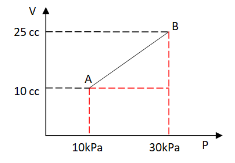
Find the work done for the process shown in the figure

(a) 1J
(b) 1.5J
(c) 4.5J
(d) 0.3J

Answer
504k+ views
Hint: The work done of the process is found by calculating the area under the curve. Redraw the diagram and extend lines to the X and Y axis from points A and B. Calculate the total area by dividing it into smaller areas. In this figure divide it into a triangular and rectangular area and then sum the values of the area. The total area will give the work done.
Formula used: \[Area{\text{ }}of{\text{ }}rectangle = {\text{ }}length{\text{ }}x{\text{ }}breadth\] ; \[Area{\text{ }}of{\text{ }}triangle{\text{ }} = \;\dfrac{1}{2}*{\text{ }}Base{\text{ * }}height\]
Complete step-by-step solution:

\[P - {\text{ }}Pressure\]
\[Pa - {\text{ }}Pascal{\text{ }}(Unit{\text{ }}of{\text{ }}pressure)\]
\[V - {\text{ }}Volume\]
\[cc - {\text{ }}cubic{\text{ }}centimeter{\text{ }}\left( {Unit{\text{ }}of{\text{ }}volume} \right)\]
The work done is calculated by summing the area under the line AB. So from the diagram, the sum of the area (area 0f the rectangle + area of the triangle) will give the work done for the process.
Given: Initial volume =\[10{\text{ }}cc\] ; Final volume = \[25{\text{ }}cc\]
Initial Pressure =\[10kPa\] ; Final pressure = \[30kPa\]
To find: work done
Area of the rectangle (from the diagram) = Length x breadth
Substituting the values, = \[\left( {30 - 10} \right){\text{* }}10\]
\[ = {\text{ }}20{\text{ * }}10\]
\[Area{\text{ }}of{\text{ }}rectangle\;\;\; = {\text{ }}200kPa.cc\]
Area of the triangle (from the diagram) = \[\;\dfrac{1}{2}{\text{* }}Base{\text{ * }}height\]
\[ = \;\dfrac{1}{2}*{\text{ }}10{\text{ * }}20\]
Simplifying, Area of triangle= \[100\] kPa.cc
The work done is the sum of the area,
Therefore, Work done= Area of rectangle + Area of triangle
Substituting the values, = \[200\] kPa.cc + \[100\] kPa.cc
Adding,= \[300\] kPa.cc
To convert cubic centimeter to cubic meter, multiply by \[{10^{ - 6}}\] (1 cubic centimeter= \[{10^{ - 6}}\] cubic meter)
Therefore, Work done = \[300{\text{ * }}{10^{ - 6}}\] kPa.m3
Since \[kPa = {\text{ }}1000\] Pa and multiplying, Work done= \[0.3\] Pa.m3
Since\[Pa.{m^3} = {\text{ }}J\] , Work done=\[0.3\]J (J- Joules)
Hence option (D) W= \[0.3\]J is the right answer.
Note: The energy that is utilized to move an object against force is called work. The work done by a gas depends on both the initial and final state of a gas. For a pressure-volume graph, the area under the curve gives the work done by the gas.
Formula used: \[Area{\text{ }}of{\text{ }}rectangle = {\text{ }}length{\text{ }}x{\text{ }}breadth\] ; \[Area{\text{ }}of{\text{ }}triangle{\text{ }} = \;\dfrac{1}{2}*{\text{ }}Base{\text{ * }}height\]
Complete step-by-step solution:

\[P - {\text{ }}Pressure\]
\[Pa - {\text{ }}Pascal{\text{ }}(Unit{\text{ }}of{\text{ }}pressure)\]
\[V - {\text{ }}Volume\]
\[cc - {\text{ }}cubic{\text{ }}centimeter{\text{ }}\left( {Unit{\text{ }}of{\text{ }}volume} \right)\]
The work done is calculated by summing the area under the line AB. So from the diagram, the sum of the area (area 0f the rectangle + area of the triangle) will give the work done for the process.
Given: Initial volume =\[10{\text{ }}cc\] ; Final volume = \[25{\text{ }}cc\]
Initial Pressure =\[10kPa\] ; Final pressure = \[30kPa\]
To find: work done
Area of the rectangle (from the diagram) = Length x breadth
Substituting the values, = \[\left( {30 - 10} \right){\text{* }}10\]
\[ = {\text{ }}20{\text{ * }}10\]
\[Area{\text{ }}of{\text{ }}rectangle\;\;\; = {\text{ }}200kPa.cc\]
Area of the triangle (from the diagram) = \[\;\dfrac{1}{2}{\text{* }}Base{\text{ * }}height\]
\[ = \;\dfrac{1}{2}*{\text{ }}10{\text{ * }}20\]
Simplifying, Area of triangle= \[100\] kPa.cc
The work done is the sum of the area,
Therefore, Work done= Area of rectangle + Area of triangle
Substituting the values, = \[200\] kPa.cc + \[100\] kPa.cc
Adding,= \[300\] kPa.cc
To convert cubic centimeter to cubic meter, multiply by \[{10^{ - 6}}\] (1 cubic centimeter= \[{10^{ - 6}}\] cubic meter)
Therefore, Work done = \[300{\text{ * }}{10^{ - 6}}\] kPa.m3
Since \[kPa = {\text{ }}1000\] Pa and multiplying, Work done= \[0.3\] Pa.m3
Since\[Pa.{m^3} = {\text{ }}J\] , Work done=\[0.3\]J (J- Joules)
Hence option (D) W= \[0.3\]J is the right answer.
Note: The energy that is utilized to move an object against force is called work. The work done by a gas depends on both the initial and final state of a gas. For a pressure-volume graph, the area under the curve gives the work done by the gas.
Recently Updated Pages
Master Class 9 Social Science: Engaging Questions & Answers for Success

Master Class 9 Science: Engaging Questions & Answers for Success

Master Class 9 English: Engaging Questions & Answers for Success

Master Class 9 Maths: Engaging Questions & Answers for Success

Master Class 11 Economics: Engaging Questions & Answers for Success

Master Class 11 English: Engaging Questions & Answers for Success

Trending doubts
Which places in India experience sunrise first and class 9 social science CBSE

Fill the blanks with the suitable prepositions 1 The class 9 english CBSE

Write the 6 fundamental rights of India and explain in detail

Difference Between Plant Cell and Animal Cell

What is the Full Form of ISI and RAW

Golden Revolution is related to AFood production BOil class 9 social science CBSE




